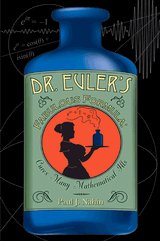Dr. Euler's Fabulous Formula
|

|
This is a wonderful book - a sequel to Nahin's earlier An Imaginary Tale: the Story of √-1. This one is more advanced. And the author clearly sets up requirements: "... two years of calculus, a first course in differential equations, and perhaps some preliminary acquaintance with matrix algebra and elementary probability. Third year math majors would certainly have the required background." I would low the bar if a little. An intelligent second year student will enjoy the book, even if it takes a little more effort. Doubt not: the extra effort will pay off.
The scope of the book is astonishing. True, the starting point is indeed the formula
| While there is some historical discussion here, too, the emphasis is now on more advanced mathematical arguments (but none beyond the skills I mentioned above), on issues that I think could fairly be called the "sexy part" of complex numbers. |
To clarify, the author's focus is on interesting and significant mathematics involving complex numbers which he presents with characteristic clarity but without missing an opportunity to lighten up the presentation with historical background, quotes and anecdotes.
To the author, a professor of electrical engineering, mathematics is a problem solving tool that he applies to a sequence of "real world" problems, like tracing an itinerary of a dog on a fixed-length leash frolicking around its running owner and cat-and-mouse pursuit (Ch. 2), vibrating strings, Gibbs' phenomenon (Ch. 4), reciprocal spreading and uncertainty principle (Ch. 5), synchronous radio receiving, speech scrambling (Ch. 6). Mathematics is employed masterfully to these and other problems, some purely mathematical. For example, the third chapter is devoted to Legendre's proof of the irrationality of π² - a rare math gem for an undergraduate book. In Chapter 4, the isoperimetric inequality is established via Wirtinger's inequality with the help of Fourier series. In fact, one way or another, mathematics in the second half of the book relates to Fourier series and integrals. There one meets the Parseval's idenity, Poisson summation formula, Cauchy-Schwartz inequality, Dirac function, Hilbert transform, and more.
The book starts with an essay on beauty in mathematics and ends with a biographical essay on L. Euler. It's a delightful and informative albeit not an easy read. There is a population of intelligent and educated people who for various reasons seek a math refresher. Usually they pick an old textbook or seek a more updated version. I would suggest that Nahin's books, in general, and Dr. Euler's Fabulous Formula, in particular, may serve as exceptionally attractive refresher sources. The mathematics is clear and detailed, the topics are carefully selected and attractive to a broad audience, the style is lucid and enthusiastic. Reading the book with pencil and paper is a good way to recollect old and learn new mathematics.
Dr. Euler's Fabulous Formula: Cures Many Mathematical Ills, Princeton University Press, 2006. Hardcover, 380 pp, $29.95. ISBN 0691118221.
|Up| |Contact| |Front page| |Contents|
Copyright © 1996-2018 Alexander Bogomolny73580422
